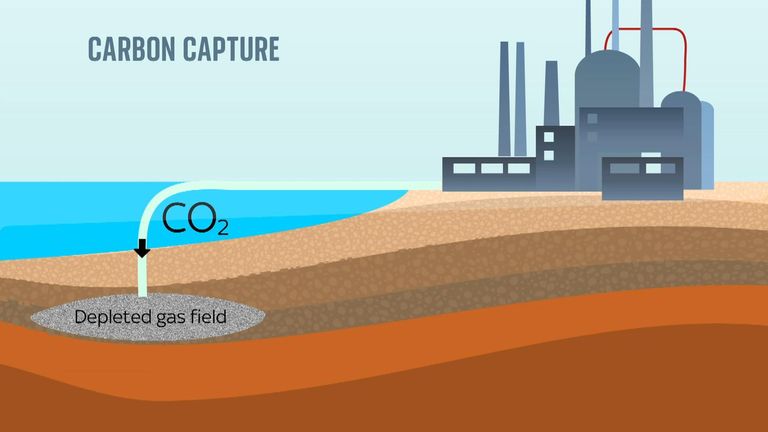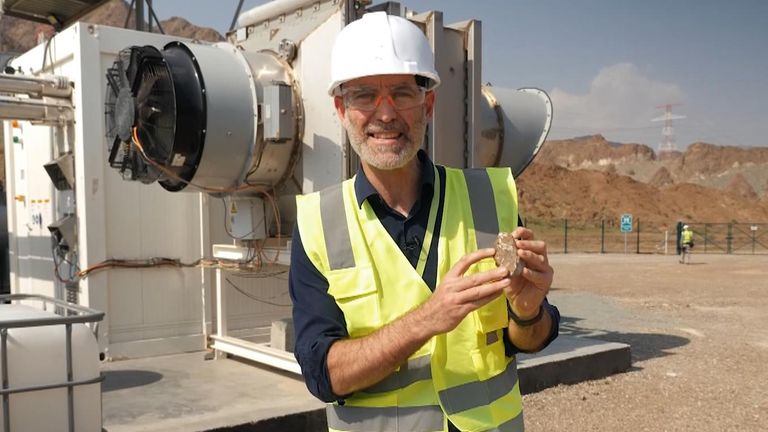The net zero technology getting an almighty £22bn cash injection from UK government
The government has pledged nearly £22bn to fund projects that capture greenhouse gases from polluting plants and store them underground, as it races to reach strict climate targets.
The plans are designed to generate private investment and jobs in Merseyside and Teesside, two industry-heavy areas that will be home to the new “carbon capture clusters”.
Energy Security and Net Zero Secretary Ed Miliband told Sky News “today a new era begins”, with a new industry that stops carbon going into the atmosphere providing “good jobs” and shows the government is investing in the country.
Prime Minister Sir Keir Starmer said the move was “reigniting our industrial heartlands by investing in the industry of the future”, though there are questions about how best to use this expensive technology.
Carbon capture, utilisation and storage (CCUS) has been developed to combat climate change.
It captures the planet-warming carbon dioxide released from burning fossil fuels or from heavy industry, and puts it to use or stores it underground.
It is expensive and difficult, but the UK’s climate advisers, the Climate Change Committee (CCC), and United Nations scientists say it is essential to get the world to net zero, which the UK is targeting for 2050.
Net zero means cutting emissions as much as possible and offsetting or capturing the stubborn remaining ones.
Today the government has committed up to £21.7bn over 25 years, to be given in subsidies to sites in the Teesside and Merseyside “clusters” – from 2028.
Analysis: After warning of tightened purse strings, the public may well be perplexed by Reeves
It will be split between three projects, which are capturing carbon dioxide released either from making hydrogen, generating gas power or burning waste to create energy from 2028.
The gas – up to 8.5 million tonnes of carbon emissions – will be locked away in empty gas fields in the Liverpool Bay and the North Sea.
The government hopes it will attract £8bn in private investment, create 4,000 direct jobs and support a further 50,000.
The cash will pay for fewer projects than hoped – the last government suggested a £20bn pot of money for similar projects – but the new administration says those plans weren’t properly costed, and the funding hadn’t been allocated.
The funding is to come from a mixture of Treasury money and energy bills, but the government has been coy about the split so far.
Sir Keir said the announcement will “give industry the certainty it needs” and “help deliver jobs, kickstart growth, and repair this country once and for all”.
How about the £22bn black hole?
The £21.7bn the government has committed to the project is notably about the same amount as the £22bn black hole Labour says the Conservative government left it with.
But, Sir Keir insisted the carbon capture and storage scheme “will unlock billions of private investment” and is certain he will soon be announcing more private investment.
Defending some unpopular decisions the government has made in its first three months, such as cutting the winter fuel payment for 10 million pensioners, Sir Keir added: “I’m absolutely convinced that only by stabilising the economy can we attract the investment that we need.”
Will CCUS help jobs and business?
The government hopes to fund the first large-scale hydrogen production plant in the UK, and help the oil and gas sector and its transferable skills move over to green industries.
It has been welcomed by industry and the unions, coming just a week after job losses from the closures of Port Talbot Steelworks and Ratcliffe coal power station.
GMB general secretary Gary Smith said the news “shows what levelling up can really mean: good, well-paid jobs reinvigorating communities”.
Does carbon capture, utilisation and storage (CCUS) work?
CCUS has made slow progress: promised for decades but barely scaled, with just 45 commercial sites globally, according to the International Energy Agency.
However, it began to pick up in the last few years, with 700 plants now in some stage of development around the world.
The world’s first CCUS plant has stored CO2 under Norway’s waters since 1996, though elsewhere a few concerns linger about whether some projects leak gas.
James Richardson, acting chief executive of the CCC, said: “We can’t hit the country’s targets without CCUS, so this commitment to it is very reassuring”.
Be the first to get Breaking News
Install the Sky News app for free



How should CCUS be used?
Some believe expensive CCUS should be preserved for areas like cement or lime production, that are very hard to clean up in any other way, whereas greener alternatives exist for things like blue hydrogen.
Blue hydrogen is clean when burned but made from natural gas, so requires ongoing imports of the fossil fuel.
Greenpeace UK’s Doug Parr warned of a “risk of locking ourselves into second-rate solutions, especially as the oil industry could easily hoover up most of the money to continue business as usual”.
The government hopes this funding for the three sites that are ready to go will lay the foundations for further CCUS projects.





